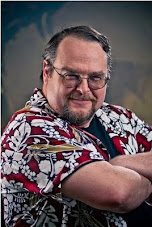Boilerplate - History's Mechanical Marvel by Paul Guinan and Anina Bennett, Abrams Image, 2009.
Where I got this book: Spy Comics. It was a light week for my regular comics pull, and the cover of the 168-page hardback shows Pancho Villa posing next to a Victorian robot. Call me an easy sell.
Boilerplate is a pictorial history of the robot of the same name who made its debut at the 1893 Chicago World's Fair and disappeared in action during WWI, and during its brief time experienced just about every important moment of that age without changing history in the least. And it makes for a very entertaining book.
Boilerplate the robot is the creation of Prof. Archibald Campion, constructed in the wake of the death of the fiance of his sister, Lily, in a military action. With the aid of fuel cell inventor Edward Fullerton, mad-science genius Nikolai Tesla, and the brilliant Frank Reade Jr, who had previous invented a steam-powered man, Campion created Boilerplate, a free-standing, self-propelled, talking robot who was supposed to replace man on the battlefield.
All those people in the previous paragraph, with the exception of the fiance and Tesla, are fictional. Furthermore, they are the ONLY fictional people in the book. In fact, Frank Reade Jr was a fictional character from earlier source: the early Edisonades, the star of Frank Reade and his Steam Man of the Plain,. Everyone else is a historical figure, including Hugh McKee, the fiance, who did die in a military action in Korea in 1871.
And that is the strange thing about Boilerplate - he and his creators Forrest-Gump their their way through the First American Age of Imperialism without leaving much of a ripple. Here is Boilerplate making his debut at the Hall of Machinery in the Chicago Exposition. Here are Archie and Boilerplate in the Klondike. Here is the robot is working with TE Lawrence, Black Jack Pershing, posing with Pancho Villa. Here is Archie dealing with the house arrest of Queen Lili'uokalani of Hawai'i. Yet in no case do they jostle history in the slightest. It is all sort of "And here is Teddy Roosevelt and the Roughriders charging up San Juan Hill (actually Kettle Hill), oh, and Boilerplate is there as well."
Boilerplate, for being a weapon of war (created so men would not be lost in battle) is extremely progressive, even for his age, and Archie and his marvel hobnob with buffalo soldiers, suffragettes, Pullman strikers, and child laborers. They peel back the cultured veneer of that gilded age and get to the human beings that the beaux-arts columns are resting upon.
The book itself is lavishly illustrated, with pieces either duplicating the artistic styles of the age (Boilerplate in a Winsor McCay piece) or using period photographs (identifying the original photographers) and inserting Boilerplate and Archie. The latter is usually targeted as being some mustachioed individual, while the latter is tucked in the background somewhere, oddly ignored for what he is.
And through it all, the book is historically accurate, once you, you know, ignore the robot, which is what a lot of those present seem to be doing. The history is rock-solid, peeking into areas forgotten by modern Americans. Yet the robot does not affect that history, other than to give it the same result as we have in our timeline. Boilerplate passes effortlessly through the process, a quiet tour guide, an excuse to pay attention to the era, but remains unchanged and changing little of the world around it.
I highly recommend this book as an tour of the Age of Imperialism and Gilded Age of America, a time when America was mechanizing and dealing with larger social issues. The period from the end of the Civil War to WWI is blipped over to a great degree in our schools, with only a head-nod to the Maine. It is an excellent history book, sheathed in the cladding of a imaginary robot, and brings a lot to the table.
More later,
My Newest Publication: DARK TOWER
-
*So, *
So, one of the things I saw at GaryCon that interested me greatly was the
new expanded edition of *DARK TOWER*, by the late great Jennnell Jaquay...
17 hours ago


